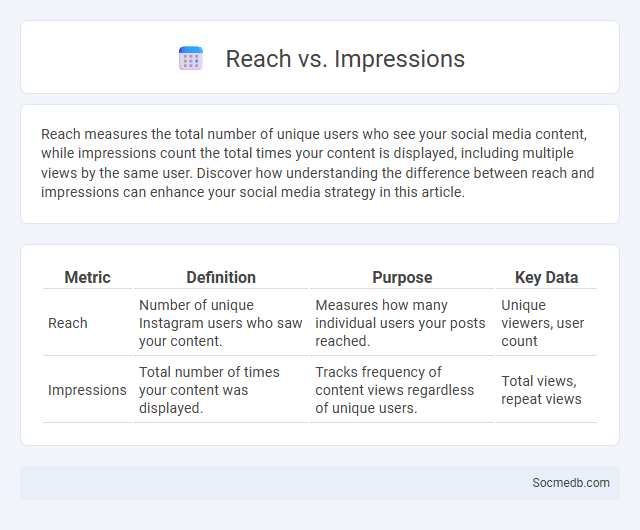
Photo illustration: Reach vs Impressions
Reach measures the total number of unique users who see your social media content, while impressions count the total times your content is displayed, including multiple views by the same user. Discover how understanding the difference between reach and impressions can enhance your social media strategy in this article.
Table of Comparison
| Metric | Definition | Purpose | Key Data |
|---|---|---|---|
| Reach | Number of unique Instagram users who saw your content. | Measures how many individual users your posts reached. | Unique viewers, user count |
| Impressions | Total number of times your content was displayed. | Tracks frequency of content views regardless of unique users. | Total views, repeat views |
Understanding the Basics: Reach vs Impressions
Reach measures the total number of unique users who see your social media content, providing insight into audience size and brand exposure. Impressions track the total number of times the content is displayed, including multiple views by the same user, reflecting content visibility and potential engagement opportunities. Analyzing both reach and impressions helps optimize social media strategies by balancing audience growth with content frequency and user interaction.
Defining Social Media Reach
Social media reach measures the total number of unique users who see your content across platforms like Facebook, Instagram, and Twitter. It differs from impressions, which count multiple views by the same user, making reach a key metric for evaluating your audience size. Understanding your social media reach helps optimize marketing strategies to maximize engagement and brand visibility.
What Are Impressions in Digital Marketing?
Impressions in digital marketing represent the total number of times your content, such as ads or posts, is displayed to users across social media platforms. This metric helps you understand the potential reach and visibility of your campaign, providing insights into how often your audience is exposed to your brand message. Tracking impressions allows you to optimize your social media strategies for better engagement and brand awareness.
Key Differences Between Reach and Impressions
Reach measures the total number of unique users who have seen your social media content, while impressions count the total number of times that content is displayed, regardless of repeat views. Your reach indicates how broadly your message has spread across different audiences, whereas impressions reflect the overall exposure and frequency of your posts. Understanding the distinction helps you optimize engagement by targeting unique viewers without over-saturating your current followers.
Why Both Metrics Matter in Your Strategy
Engagement metrics reveal how actively your audience interacts with your content, highlighting your brand's relevance and connection to followers. Reach metrics measure the total number of unique users exposed to your content, indicating the potential visibility and growth of your social media presence. Balancing both metrics enables you to optimize your strategy for maximum impact and meaningful audience relationships.
How to Measure Reach and Impressions Effectively
Measuring reach and impressions effectively on social media involves analyzing platform-specific analytics tools such as Facebook Insights, Instagram Analytics, and Twitter Analytics. Reach quantifies the number of unique users who have seen your content, while impressions indicate the total number of times the content has been displayed, including multiple views by the same user. Leveraging key performance indicators (KPIs) like engagement rate, click-through rate (CTR), and follower growth alongside reach and impressions provides a comprehensive understanding of content performance and audience impact.
Factors Influencing Reach and Impressions
Content quality, audience engagement, and posting frequency significantly influence your social media reach and impressions. Algorithms prioritize posts with higher interaction rates, timely relevance, and multimedia elements like videos or images. Understanding platform-specific behaviors and optimizing posting times can amplify visibility and extend content reach effectively.
Optimizing Content for Maximum Reach
Maximizing social media reach requires strategic content optimization through targeted keywords, engaging visuals, and consistent posting schedules. Leveraging platform-specific algorithms and incorporating trending hashtags significantly enhance visibility and audience engagement. Analyzing performance metrics allows for refining content strategies to boost organic reach and foster community growth.
Boosting Impressions Without Raising ad Spend
Maximizing social media impressions without increasing ad spend involves optimizing content for organic reach and leveraging audience engagement. Utilizing targeted hashtags, posting during peak engagement times, and encouraging shares and comments can amplify visibility. Employing high-quality visuals and interactive formats like stories and polls further enhances user interaction, driving broader exposure efficiently.
Reach vs Impressions: Which Metric Should You Prioritize?
Reach measures the total number of unique users who see your content, while impressions count how many times your content is displayed, regardless of repetition. Prioritizing Reach helps expand your audience by targeting new users, whereas focusing on Impressions can increase engagement with existing followers. Your choice depends on campaign goals, with Reach boosting brand awareness and Impressions enhancing content visibility and frequency.
 socmedb.com
socmedb.com